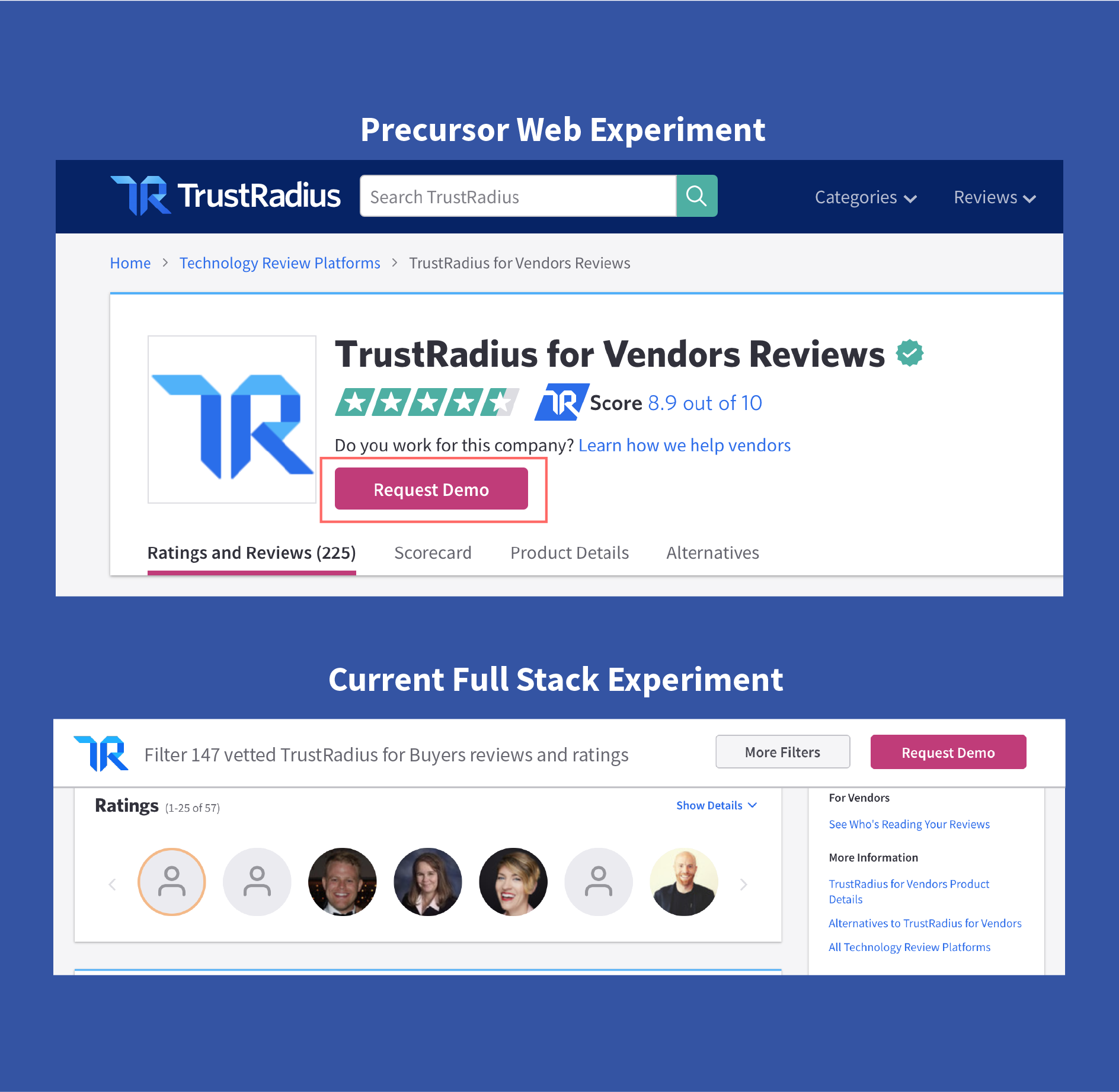Why TrustRadius runs 90+ experiments per year
Trusting experimentation to get it right
TrustRadius is the fastest growing, most trusted customer voice and insights platform that helps tech buyers make great decisions and helps technology vendors acquire and retain great customers. Each month, over 1 million B2B technology buyers use verified reviews and ratings on TrustRadius.com to make informed purchasing decisions. Sitting behind this large audience is a hugely innovative team made up of full stack engineers and product managers – all using experimentation through Optimizely to make a huge impact on the TrustRadius user experience for millions of users across the globe.
"When building products you don’t want to make expensive mistakes. Experiments help us stay user centered, mitigate risk, and increase adoption by incorporating user feedback early on."
Testing its way into testing
TrustRadius literally tested its way into testing, just over two years ago. The smart and agile team has placed experimentation at the centre of its ethos of being a customer-first platform, constantly looking for new ways to innovate and improve. The TrustRadius team began their journey into experimentation using a free solution, but soon outgrew it and started looking for one that would better serve its business needs. The team actually used the TrustRadius site to search for the best user-rated experimentation platform – landing on Optimizely. The rest is history, with TrustRadius running 90 experiments, utilizing Optimizely’s full platform including the Full Stack and Web products in the past year alone.
TrustRadius has used experimentation to push the boundaries of what was possible with the user experience. The team had a central focus on reaching 100 percent of its audience, ensuring its users find the right insights to make the best decisions possible. This meant that community feedback from end users was integral to TrustRadius creating the best possible user experience. It was impossible to address feedback from millions on a 1:1 basis but, using Optimizely, the team was able to review metrics immediately reflecting the kinds of experiences users were having with each test. This meant user feedback could be embedded into any stage of the product decision loop (idea, build, launch, learn) and help the team improve decisions and steer clear of costly mistakes.
Ready, steady, experiment!
TrustRadius started experimentation on one of its highest performing features, its TrustMaps. TrustMaps are charts that help users compare specific software products, based on real-time, end-user data. Due to these charts containing huge quantities of complex content, the pages that have TrustMaps took a longer than ideal time to load and in turn, was disrupting the user experience.
The team knew they needed to fasten page load time, but were very conscious not to make changes that could be at the detriment of other functions on the page, as this could hinder user engagement as well. They set about trialling different options of what could be shown on the TrustMap. Eventually finding that the best performing option was the use of a static image on the main landing page, which customers could then click on, to gain access to the full TrustMap and its in depth information. This meant users had faster access to the data that mattered to them, without waiting on a lot of unneeded data to load on the initial page.
The team saw a huge difference in results. The winning TrustMap variation had four times the number of user interactions compared to the other variations the team tested. Furthermore, the average page load time reduced by 0.2 seconds and the exit rate also reduced by 3 percent. A win for all.
Calling out the call to actions
One of TrustRadius’ most successful experiments to date has been testing the location of its call to action (CTA) buttons on the site. They knew from survey research that half of software buyers consult vendors during their purchase journey, so based on that, they concluded that many buyers would want a vendor demo. However, the CTA button that took customers to the demo was getting lost when users scrolled down the page.
The team thought that if they made it easier for buyers to find the demo CTA button, they’d get an increased click through rate and achieve a better user experience. They ran an experiment to test this hypothesis. This involved changing the location of the button, placing the call to action in a static, header location. Based on initial results, the team experienced an incredible 2xs increase in clicks, having made this move! With this clear evidence of success, the team could then invest in making this a permanent location change for that CTA button.

After seeing such success with experimentation on the CTA button for vendor demos, TrustRadius then conducted a similar experiment on the location of its ‘claim link’ CTA button. After trialling different locations on the page, the team managed to increase the weekly vendor profile claims more than 200 percent!
What's next
We plan to continue to use Optimizely to stay user-centered and make informed product decisions, and scale our experimentation program as our company and audience continues to grow.
We'll continue improving our platform's ability to connect millions of professionals with the right B2B technology answers, at the right time -and this will require hundreds of new experiments across web and full stack, ranging in complexity from point mutations to validation of large roadmap initiatives.
The areas we're specifically experimenting with in the near-term are areas we can help buyers more easily evaluate products using our platform. This means testing into new kinds of content and data, provided in ways that are easy to navigate and personalized to each buyer's specific use cases.

